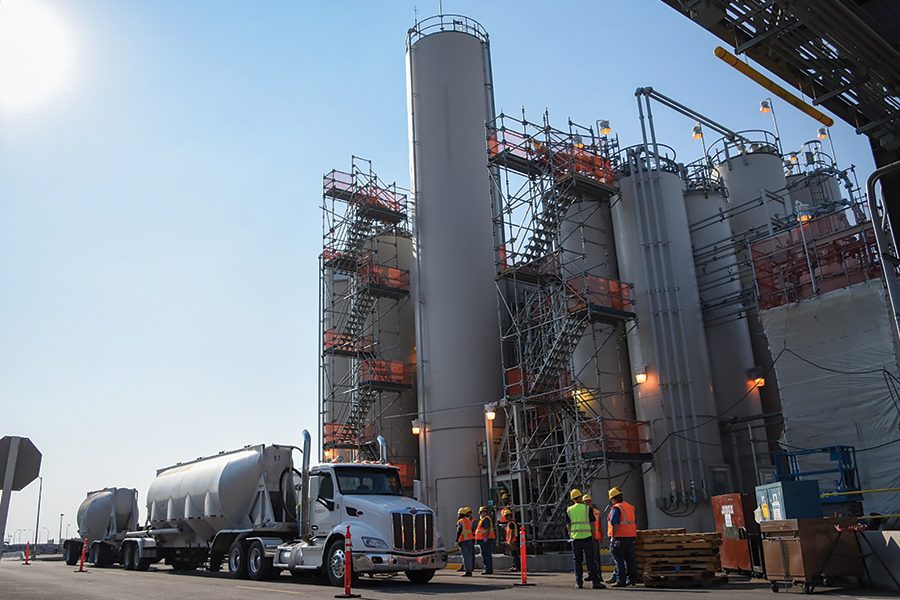
Home » Pasco company supplies ingredients to bake Hanford waste into glass
Pasco company supplies ingredients to bake Hanford waste into glass

September 13, 2021
A Pasco ag chemical firm is supplying the Hanford site with the ingredients it needs to bake radioactive and hazardous waste into borosilicate glass logs at the $17 billion Waste Treatment & Immobilization Plant.
Two Rivers Terminal delivered a 35,000-pound load of lithium carbonate to Hanford this summer, the first of what promises to be thousands of deliveries of the dozen or so chemicals that form the recipe to vitrify millions of gallons of waste, stabilizing it for millennia to come.
It is a striking moment for Hanford. The focus has long been on building the complex vitrification facility and the supporting infrastructure. Now, attention is shifting to actual production, with vitrification currently set to begin in 2024.
Construction of the direct-feed low activity waste facility, or DFLAW, at the treatment plant wrapped in December 2020. That sets the stage for testing and, later this year, heating up the melters where waste and glass-forming chemicals will be superheated to 2,10 degrees Fahrenheit, then poured into stainless steel containers to cool.
For Two Rivers Terminal, which imports powdered chemicals from around the world, providing ingredients to Hanford is an honor and good for business. The contract amount is confidential.
The company dedicated a warehouse and four employees to the Hanford contract, which helped it smooth out the seasonal nature of demand from its traditional ag clients, said Steve Peot, general manager.
That means the 85-person company with offices in Moses Lake and China can hire more full-time rather than part-time employees.
Peot said Hanford is an exacting customer that wants the materials it purchases tested at every step, from the original source through transport, storage and delivery.
“They are very good at knowing what they want and getting what they want,” he said.
Pasco-based Mukang Labs is working with Two Rivers Terminal to confirm all materials meet Hanford’s quality standards.
For Hanford managers, delivery of the first load of glass-forming materials together with the arrival of the metal containers to hold the glass mixture is yielding results.
“I was so excited to see those get here, I can’t tell you. It’s starting to be real,” said Ross Hamlett, melter heat up completion team manager for the Waste Treatment Completion Company, a subcontractor to Bechtel National Inc., the U.S. Department of Energy contractor responsible for building the treatment plant and support facilities.
The glass emerging from the vit plant will be no ordinary formulation. Scientists spent years perfecting the recipe, which must be stable enough to last thousands of years while leading to the minimum amount of glass logs sent to storage.
Two Rivers Terminal’s first delivery was small and will not be used to treat actual waste. Hamlett said the initial delivery was needed for testing, to ensure the dry, powdery chemical compound flows from the storage silo through a hopper, pipes and into the treatment system the way engineers expect.
Like ordinary baking flour, powdered chemicals can be fluffed with air to flow like a liquid. Engineers are testing each ingredient in the formula to ensure it moves at the right rate and concentration through the system to ensure the final mix is perfect before it goes to the melter.
Hamlett said the team conducted a total of 10 transfers using about 12,000 pounds of lithium carbonate. The test was a success.
Hamlett expected to test magnesium silicate, another glass-forming chemical in the vitrification recipe, around Labor Day. Other ingredients include silica, sucrose and various oxides – titanium, zinc, ferrous, zirconium, aluminum and more.
Hamlett likens the final product – borosilicate glass – to his wife’s beloved Pyrex measuring cups, another example of the borosilicate recipe. It is highly stable under extreme temperature changes. Pour boiling water into a frozen Pyrex container and it won’t shatter.
Treatment is expected to begin in 2024 after being delayed several months by the Covid-19 pandemic. Once it does, Hanford’s appetite for glass-forming chemicals will be significant, with five truckloads arriving per day to keep up with demand for 50,000 pounds of materials.
Each low activity waste, or LAW, container enters the melter system weighing about 13,000 pounds, including about 10,000 pounds of glass-forming materials. The actual waste and the container represent the rest.
“We expect to keep Two Rivers Terminal pretty busy bringing truckloads of material out to us,” Hamlett said. As part of its contract, Two Rivers Terminal will always keep a three-month supply at the ready.
When operational, the Waste Treatment & Immobilization Treatment Plant will handle an estimated 56 million gallons of radioactive and hazardous wastes that were stored in 177 underground tanks. About a third are leaking, threatening the Columbia River.
Hanford’s tank waste is the result of weapons-related plutonium-production efforts during World War II and the Cold War eras.
Local News
KEYWORDS september 2021




